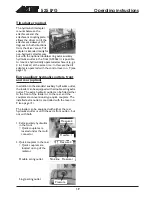
Operating instructions
22
525 LPG
7
NOTICE!
The engine cannot start if the
auxiliary hydraulics control lever is in the
locking position.
If the loader is equipped with conventional
quick couplers, operating direction of the
attachment depends on the coupling of
the attachment hoses and the direction
in which the auxiliary hydraulics control
lever is moved. Make sure that there are
no persons in the danger area when testing
the operating directions. Change the place
of the hoses if necessary.
Going near an attachment that is in
operation can cause a serious risk. Switch
off auxiliary hydraulics before leaving
drivers seat or stopping the engine.
Operate the controls only when sitting in
the drivers seat.
Steering of the machine
Steering of the machine happens with the steering
wheel. The steering wheel is hydraulically powered.
A practical way of steering is to steer with your left
hand on the knob of the steering wheel. This way
your right hand is free to operate other functions.
Pay attention to other machines and persons that are
moving in the area. Make sure that there are no
persons in the danger zone of the loader and the
attachment. The danger zone of the loader covers
the reach area of the loader boom, the turning area
on the side and in the front and rear of the loader.
Always put down the load when leaving the machine
the loader is not designed to stay with the loader
boom and load lifted. Learn how to operate the loader
in a safe place.
Loader control
The loader boom and bucket are controlled with the
multi-function lever sideways (tilt) and back & forward
(boom up & down).
Pull backward to lift the boom
Push forward to lower the boom
Push left to raise the tip of the bucket (filling)
Push right to lower the tip of the bucket (emptying)
Using the auxiliary hydraulics
Auxiliary hydraulics (hydraulically operated
attachments) are controlled with the lever no.
on the control panel, or with the buttons on the
joystick (see page 18). The lever locks in the locking
position (on the right) which facilitates operation of
the attachments that require constant oil flow (rotary
broom, backhoe etc.).
7
Always remember safety first. Test all
the functions of the loader at an open and
safe place. Make sure that there are no
persons in the operating area of the
machine and the danger zone of the
attachment.
When driving, always keep the loader
boom as low as possible. Risk of tipping
over increases considerably when there
is a heavy load on the loader (a heavy
attachment or a big load in the bucket)
and the boom is up when driving.
Never use a high drive speed when turning.
In particular: when the loader boom is up
the stability of the machine is much weaker
when turning.
Remember that, when turning, the driver´s
seat extends beyond the turning radius of
the wheels. Stay inside the safety frame
(risk of collision and crushing).



































